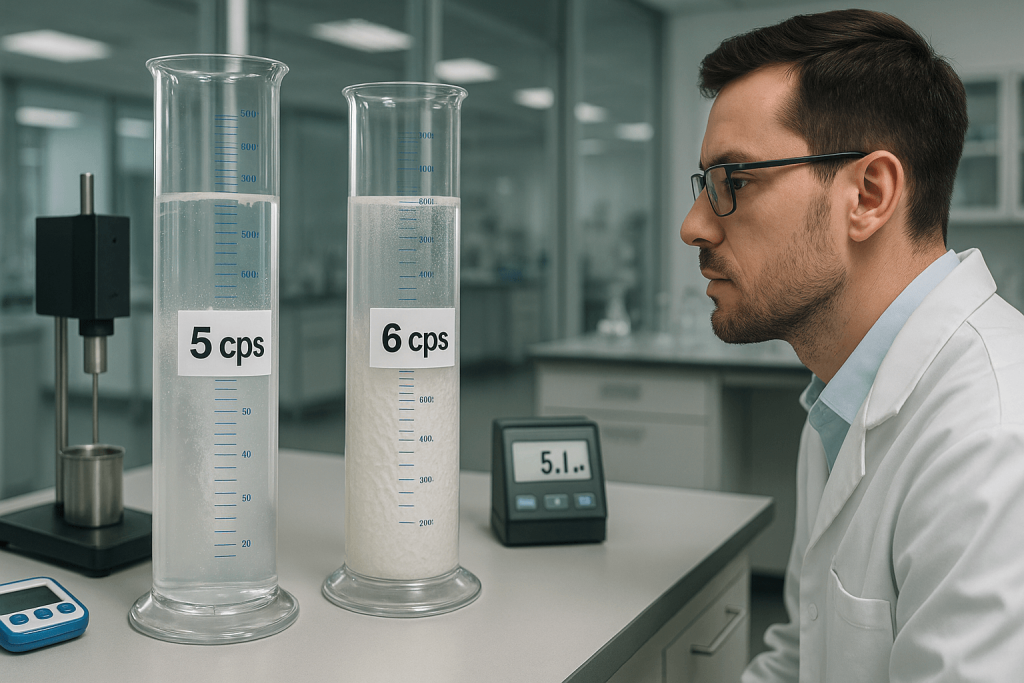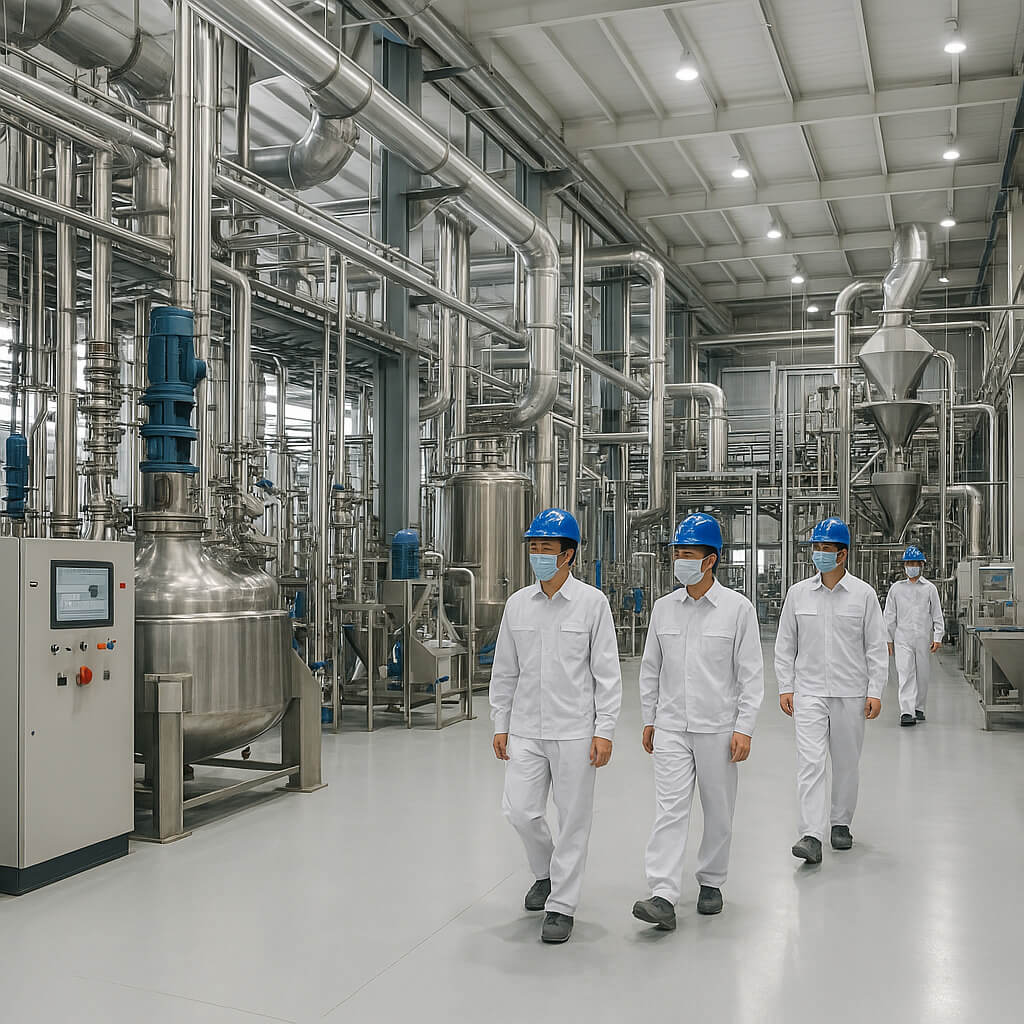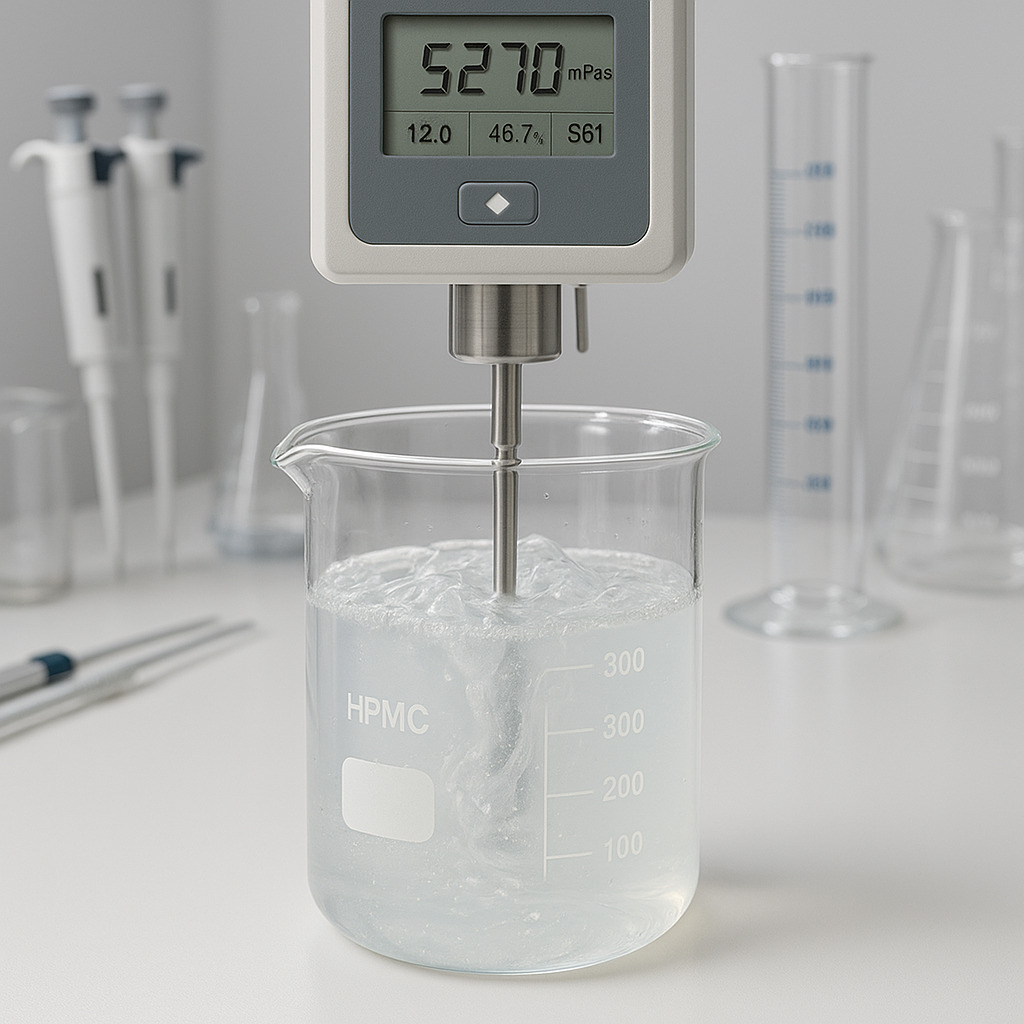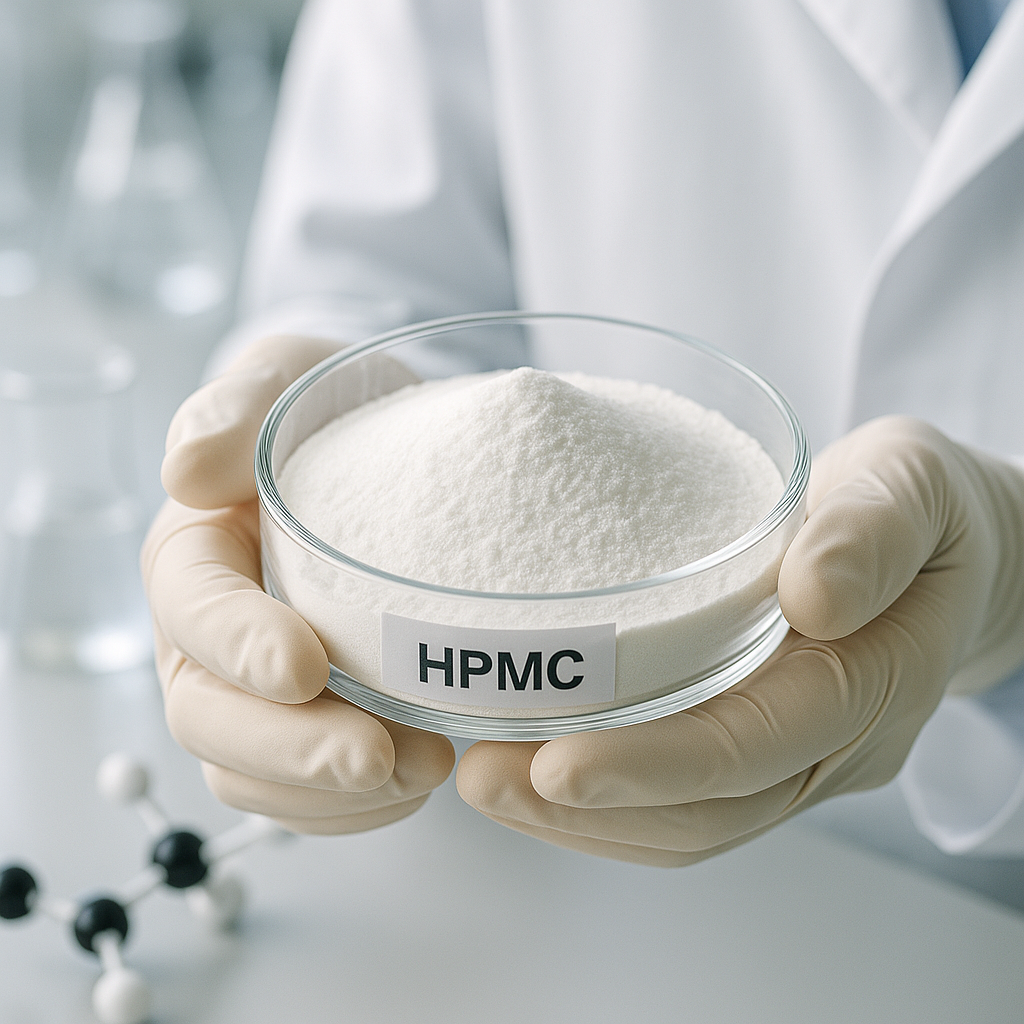When it comes to choosing the right Hydroxypropyl Methylcellulose (HPMC) for your application, the decision between 5 cps and 6 cps can be a game-changer. Aber hier ist der Clou—the difference in viscosity can significantly impact how HPMC performs in various industries, from pharmaceuticals to construction materials. Was ist die wahre Geschichte? In this article, we’ll dive into the key differences between HPMC 5 cps and 6 cps, so you can determine which grade is right for your specific needs. From understanding viscosity to selecting the best fit for your industry, we’ll cover everything you need to make an informed decision.

1. Was ist Hydroxypropylmethylcellulose (HPMC)?
HPMC is a non-ionic, water-soluble polymer derived from cellulose. It’s widely used across industries such as pharmaceuticals, food, cosmetics, and construction due to its thickening, binding, and film-forming properties. Bereit für den guten Teil? HPMC’s ability to modify the viscosity of a product is a key factor that determines its application in various formulations.
In pharmaceuticals, for example, HPMC serves as a binder in tablet formulations, a stabilizer in suspensions, and a controlled-release agent. This is where it gets interesting… In construction, HPMC is used in tile adhesives, dry mortars, and other construction materials to improve workability and adhesion. Its versatility makes it an essential component in many industries.
HPMC grades vary in viscosity, with the most common being 5 cps and 6 cps. But here’s the catch—while they may seem similar, the differences in viscosity levels between these grades play a significant role in how they perform in different applications. Understanding the properties of HPMC and how these properties affect your products will guide you in making the right choice.
| Eigentum | HPMC 5 cps | HPMC 6 cps |
|---|---|---|
| Viskosität | Untere | Höher |
| Primary Use | Pharmazeutika, Lebensmittel | Pharmaceuticals, construction |
| Auflösungsrate | Faster | Slower |
| Common Industries | Food, Pharma | Pharma, Construction |
2. What are the Key Differences Between HPMC 5 cps and 6 cps?
When comparing HPMC 5 cps to HPMC 6 cps, the most notable difference is the viscosity. What’s the real difference? The viscosity of HPMC determines how thick or thin a solution or suspension will be. Higher viscosity grades, such as HPMC 6 cps, tend to form thicker solutions, while lower viscosity grades, such as HPMC 5 cps, result in thinner formulations.
For pharmaceutical applications, HPMC 5 cps is often chosen for its faster dissolution rate, which is ideal for creating quicker-acting drug formulations. On the other hand, HPMC 6 cps is preferred when slower dissolution is needed, such as in controlled-release medications. Aber hier ist der Clou—this difference in dissolution rates can impact the overall performance and effectiveness of the final product.
In construction, the differences between these two grades are equally significant. HPMC 6 cps is commonly used in tile adhesives and dry mortar applications because it provides better water retention and improves the workability of the mixture. This is where it gets interesting… HPMC 5 cps, while still useful in construction, is more suitable for applications that do not require as much thickening or extended open time.
| Anwendung | HPMC 5 cps | HPMC 6 cps |
|---|---|---|
| Pharmazeutische | Schnell wirkende Formulierungen | Controlled-release tablets |
| Konstruktion | Lightweight formulations | Heavy-duty adhesives |
| Auflösungsrate | Faster | Slower |
3. How Do You Choose Between HPMC 5 cps and 6 cps?
Choosing between HPMC 5 cps and 6 cps depends largely on the specific requirements of your application. This is where the fun begins—viscosity is not the only factor at play. For example, if you are formulating a product that requires quick dissolution, such as a pharmaceutical tablet that releases its active ingredients immediately, HPMC 5 cps may be the better choice. Conversely, if you need to slow down the release of the active ingredients, HPMC 6 cps might be the way to go.
When selecting the right grade of HPMC for construction applications, consider the workability, water retention, and adhesive properties you need. So läuft's—if your application involves a product that needs to stay workable for a longer period of time, like tile adhesives, HPMC 6 cps will offer better performance. However, if your product is designed for faster application or drying, HPMC 5 cps may be a better fit.
Additionally, factors like cost, regulatory requirements, and the desired final product characteristics should influence your decision. Was ist die wahre Geschichte? The right grade of HPMC can improve not only the performance of your product but also the manufacturing process, making it more efficient and cost-effective.
| Faktor | HPMC 5 cps | HPMC 6 cps |
|---|---|---|
| Primary Consideration | Fast dissolution, light viscosity | Slow dissolution, heavy viscosity |
| Ideal für | Quick-release products | Controlled-release products |
| Verarbeitbarkeit | Mäßig | Hoch |
4. What are the Benefits of Using HPMC 5 cps?
HPMC 5 cps offers several advantages, particularly in applications requiring lower viscosity. What’s the real advantage here? The lower viscosity makes it an ideal choice for products that need to dissolve quickly or have a thin consistency. In pharmaceutical formulations, HPMC 5 cps is often used to create fast-acting tablets or suspensions.
In the food industry, HPMC 5 cps is used as a stabilizer, thickener, and emulsifier. Its ability to modify the texture of food products makes it a popular choice in dairy products, dressings, and sauces. Aber hier ist der Clou—HPMC 5 cps is also commonly used in gluten-free formulations, providing the desired consistency without the need for gluten.
For construction, HPMC 5 cps is often added to dry mixes to improve flowability and reduce clumping. This is where it gets interesting… It’s especially useful in applications like plaster and gypsum boards, where the mix needs to flow easily without creating too much thickness.
| Industrie | HPMC 5 cps | HPMC 6 cps |
|---|---|---|
| Pharmazeutische | Fast-dissolving tablets | Slow-release formulations |
| Essen | Stabilizer, thickener | N/A |
| Konstruktion | Lightweight mixtures | Heavy-duty adhesives |
5. What are the Benefits of Using HPMC 6 cps?
HPMC 6 cps, with its higher viscosity, is a versatile solution for applications requiring thicker consistency. What’s the advantage here? This grade is widely used in industries where the formulation requires longer work time, such as in tile adhesives and cement-based products. Its ability to retain water and improve adhesion properties makes it ideal for construction materials.
In pharmaceuticals, HPMC 6 cps is often used in controlled-release drug formulations. The increased viscosity helps slow down the release of the active ingredient, ensuring it is absorbed gradually over time. Aber hier ist der Clou—this can be particularly beneficial for drugs that require a consistent release over several hours.
In food applications, HPMC 6 cps is used as a stabilizer in emulsions, helping maintain consistency and prevent separation. It is also found in gluten-free products, improving texture and mouthfeel without relying on gluten.
| Industrie | HPMC 5 cps | HPMC 6 cps |
|---|---|---|
| Pharmazeutische | Fast release formulations | Controlled release formulations |
| Essen | Emulsifier, stabilizer | Thickener, stabilizer |
| Konstruktion | Mäßige Viskosität | Heavy-duty adhesives |
6. How Does the Viscosity of HPMC Impact Your Application?
Viscosity plays a pivotal role in how HPMC behaves in different formulations. But here’s the deal—higher viscosity means a thicker, more gel-like consistency, while lower viscosity results in a thinner, more liquid-like formulation. This simple property determines how HPMC will affect the product’s texture, flow, and stability.
For instance, in pharmaceuticals, the viscosity of HPMC affects the release rate of the drug. Bereit für den guten Teil? A higher viscosity grade like HPMC 6 cps can slow down the release, making it ideal for controlled-release medications. On the other hand, HPMC 5 cps is preferred in situations where fast dissolution is required, such as for immediate-release tablets.
In construction, viscosity determines how easily the product can be applied. Was ist die wahre Geschichte? HPMC with a higher viscosity ensures that mortar, tile adhesives, and other construction materials stay workable for a longer period of time. This allows for better application and reduces the risk of premature drying.
| Anwendung | HPMC 5 cps | HPMC 6 cps |
|---|---|---|
| Pharmazeutische | Quick dissolution | Slow-release formulation |
| Konstruktion | Fast-drying adhesives | Extended workability |
| Essen | Thinner texture | Thicker texture |
7. What are the Key Considerations for HPMC in the Food Industry?
The food industry requires ingredients that can deliver consistent texture, stability, and taste. This is where it gets interesting… HPMC is a go-to ingredient for modifying viscosity, stabilizing emulsions, and providing texture without relying on gluten. When selecting the right grade for food products, it’s essential to understand the viscosity and its impact on the final product.
For example, in dairy products like ice cream, HPMC 6 cps can enhance creaminess, while in salad dressings, HPMC 5 cps ensures the product doesn’t become too thick. Aber hier ist der Clou—using the wrong grade can lead to undesirable changes in texture, taste, or stability.
In gluten-free baking, HPMC plays a crucial role in providing the necessary texture and mouthfeel. Was ist die wahre Geschichte? HPMC 5 cps is often used in gluten-free bread and pastries to mimic the texture of traditional wheat-based products.
| Food Product | HPMC 5 cps | HPMC 6 cps |
|---|---|---|
| Ice Cream | Creaminess | N/A |
| Salad Dressings | Smooth texture | N/A |
| Glutenfreies Backen | Light texture | N/A |
8. What are the Key Considerations for HPMC in the Pharmaceutical Industry?
In pharmaceuticals, HPMC serves as a critical excipient in drug formulations. Was ist die wahre Geschichte? The grade of HPMC used in pharmaceuticals influences the rate at which the drug is released into the body, impacting the effectiveness of the treatment.
HPMC 5 cps is typically used in immediate-release formulations where rapid dissolution is desired. Bereit für den guten Teil? HPMC 6 cps, on the other hand, is ideal for controlled-release formulations, as it slows down the release of the active ingredient over time. This ensures that the drug maintains a steady concentration in the bloodstream, improving therapeutic efficacy.
When selecting HPMC for pharmaceuticals, it is important to consider factors like dissolution rate, formulation stability, and release profile. Aber hier ist der Clou—choosing the wrong viscosity grade can affect the bioavailability of the drug.
| Pharmaceutical Use | HPMC 5 cps | HPMC 6 cps |
|---|---|---|
| Immediate-release tablets | Fast release | N/A |
| Controlled-release tablets | N/A | Slow release |
| Suspension formulations | Schnelle Auflösung | N/A |
9. How Does HPMC Affect Construction Materials and Adhesives?
In construction, HPMC is used to modify the properties of dry mixes, enhancing performance and workability. So läuft's—the viscosity of HPMC determines how long the mixture remains workable before it starts to set.
HPMC 6 cps is preferred in heavy-duty applications like tile adhesives, where extended open time is crucial for the application process. Was ist die wahre Geschichte? This higher viscosity grade improves adhesion and water retention, allowing for more efficient application.
For lighter applications, like plaster or drywall compounds, HPMC 5 cps is often used. Its lower viscosity makes it ideal for improving flowability without significantly affecting the thickness or drying time of the mixture.
| Anwendung | HPMC 5 cps | HPMC 6 cps |
|---|---|---|
| Fliesenkleber | N/A | Heavy-duty adhesive |
| Plaster and Dry Mixes | Lightweight formula | N/A |
| Wassereinlagerungen | Mäßig | Hoch |
10. How Can You Ensure the Quality of HPMC for Your Application?
Ensuring the quality of HPMC involves understanding the specifications, manufacturing processes, and testing standards. Bereit für den guten Teil? It’s essential to work with a trusted supplier who can provide verifiable quality control data.
Look for HPMC products that comply with industry standards and undergo rigorous testing. Aber hier ist der Clou—always verify the viscosity grade to make sure it meets the requirements of your application. In some cases, a simple test can confirm whether the product is within the desired viscosity range.
Testing methods include rheological tests, dissolution tests, and chemical composition analysis. Was ist die wahre Geschichte? These tests ensure that HPMC will perform as expected in your product, providing consistency and reliability.
| Quality Control Method | Test Type | Zweck |
|---|---|---|
| Viscosity Test | Rheological | Measure thickness |
| Chemical Composition | Composition Analysis | Confirm purity |
| Leistungstests | Dissolution Testing | Confirm dissolution rate |
Abschluss
In conclusion, choosing between HPMC 5 cps and 6 cps depends on several factors, including viscosity, application requirements, and industry standards. So läuft's—understanding how each grade behaves in different formulations is key to selecting the right one for your needs. Whether you need fast-dissolving tablets, controlled-release pharmaceuticals, or heavy-duty adhesives, HPMC can offer the perfect solution.
By considering the specific properties and applications of each grade, you can optimize your formulations and ensure the best results. Ready to make the right choice? Reach out to a trusted supplier today to explore the best options for your application.
FAQ-Bereich
Frage 1: Was ist Hydroxypropylmethylcellulose (HPMC)?
HPMC is a cellulose-derived polymer used widely in pharmaceuticals, food, cosmetics, and construction. It serves as a thickener, binder, and stabilizer in various products.
Frage 2: How does HPMC 5 cps differ from HPMC 6 cps?
HPMC 5 cps has lower viscosity and is ideal for fast-dissolving formulations, while HPMC 6 cps has higher viscosity, making it better suited for controlled-release formulations and heavy-duty applications.
Frage 3: What factors should I consider when choosing between HPMC 5 cps and 6 cps?
Consider the viscosity requirements, application needs, industry standards, and dissolution rates when choosing the right grade of HPMC for your formulation.
Frage 4: How does HPMC affect the formulation of pharmaceutical products?
HPMC acts as a binder, stabilizer, and controlled-release agent in pharmaceuticals. The viscosity grade affects how fast or slow the drug dissolves, influencing the drug’s effectiveness.
F5: Can HPMC be used in food applications?
Yes, HPMC is used in food products as a stabilizer, thickener, and emulsifier. It enhances texture and consistency, particularly in gluten-free products.




